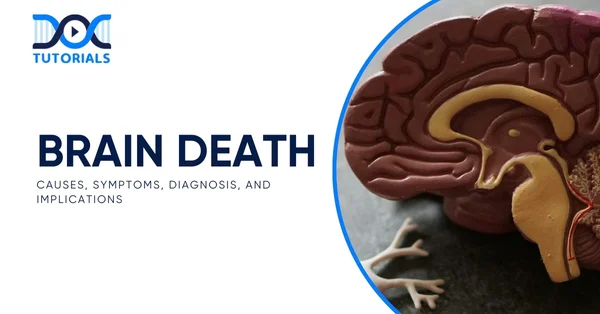Brain Death: Causes, Symptoms, Diagnosis, and Implications

Brain death is a condition of the human body whereby all the activities of the brain stop. This condition affects the entire brain rather than a specific part and is legally recognised as death. The brain is a vital organ responsible for regulating essential functions such as breathing and circulation. Its total dysfunction results in the impossibility of the survival of an individual. Brain death can be complex and usually brings about ethical and clinical complexities in its diagnosis and care.
If you are a candidate appearing for the NEET PG exam, it is crucial to understand the causes, symptoms, and other associated details of brain death. Such knowledge is essential for accurate clinical diagnosis and informed decision-making.
Read on to explore this topic in depth.
What is Brain Death?
It refers to a medical condition in which all the brain activity of an individual comes to a complete and irreversible stop. This condition is caused by a serious injury or ailment that leads to permanent, extensive impairment to the whole brain and brainstem. The brainstem controls the vital processes of the body, such as breathing and heart rate, whereas the other part of the brain controls the sensory perception as well as motor control.
As these brain functions are essential for sustaining life, a diagnosis of brain death is legally regarded as death. Medical practitioners will follow pre-established clinical guidelines to determine brain death. It involves the complete elimination of any other alternative causes of the problem or condition before undertaking a series of diagnostic tests.
What are the Causes of Brain Death?
Brain death results from irreversible brain damage caused by a total loss of oxygen and blood flow to the brain. This condition commonly arises from the following critical medical events:
- Severe Head Injury
Brain injury may be caused by traumatic events like road accidents, falls, or extreme hits and blows to the head. This may result in severe damage to the brain and cause brain death.
- Intracranial Haemorrhage
Rupture of blood vessels in the brain may cause serious bleeding that can alter the normal functioning of the brain completely.
- Stroke
Failure of the brain to receive oxygen and blood supply due to clotting or blockage of the blood vessels can cause the brain to become permanently damaged, eventually leading to brain death.
- Critical Electrolyte or Metabolic Disturbances
Imbalances in the levels of sodium, potassium or glucose may play a life-threatening role in influencing brain activity, causing total blackout.
- Central Nervous System Infections
Infections, such as meningitis or encephalitis, which affect the brain and spinal cord, can severely impair brain functionality and lead to total brain dysfunction.
- Extended Oxygen Deprivation
Events like cardiac arrest, near-drowning, severe allergic reactions or airway obstruction can deprive the brain of oxygen for a prolonged period, leading to widespread cell death.
- Brain Tumours
An aggressive tumour in the brain can create pressure on other tissues and interfere with critical functions of the brain that could result in brain death.
- Toxic Exposure
An overdose of alcohol, drugs or exposure to poisonous chemicals may cause permanent damage to the brain tissue and impair its functioning.
- Severe Cerebral Oedema
The major swelling of the brain may elevate the pressure in the head, pressing the brain stem and halting all brain functioning.
What are the Risk Factors of Brain Death?
Various risk factors can elevate the chances of brain death. They are as follows:
- Age
Younger people tend to face a greater risk of traumatic brain injuries, whereas older adults are more prone to strokes, both of which can lead to brain death.
- Gender
According to statistical data, more males are prone to traumatic brain injuries than females.
- Geographical Region
Areas that have a high frequency of accidents or violence normally have more identified brain death cases.
- Pre-existing Health Conditions
Individuals with underlying medical issues, such as heart disease or neurological disorders, face an increased risk of developing conditions that may result in brain death.
What are the Symptoms of Brain Death?
The following are some brain death symptoms:
- Complete Loss of Consciousness
The individual remains in a state of deep unresponsiveness, showing no signs of awareness or reaction to external stimuli.
- Absence of Brainstem Reflexes
All reflexes controlled by the brainstem are absent. For instance, the pupils remain fixed and dilated without reacting to light, eye movements are absent during tests like the caloric (ice water) test, the corneal reflex (blinking) is lost, and there are no signs of gag or cough reflexes.
- Inability to Breathe Independently
When the patient is not able to breathe without a ventilator, and it becomes the only way of survival.
- No Electrical Brain Activity on EEG
An electroencephalogram shows there is no brain activity at all, which is an indication that the brain has stopped functioning altogether.
- Complete Loss of Cerebral Blood Flow
Imaging methods like Doppler ultrasonography or angiography of the brain will verify that the circulation of blood to the brain has ceased.
- Impaired Thermoregulation and Cardiovascular Control
The shutdown of brain functions disrupts the body’s ability to regulate temperature and heart activity, resulting in hypothermia and increased reliance on life-support systems.
- Failure to Respond to Stimuli or Commands
No response to verbal or physical stimulus can be observed, and this further attests to the fact that there is no neurological functioning.
How to Diagnose Brain Death?
Diagnosing brain death requires a comprehensive clinical assessment, which includes the following steps:
- Review of Medical History
Causes of brain dysfunction are determined by clinicians through the events and illnesses that contributed to the said state.
- Physical Assessment
A detailed physical examination is carried out to evaluate neurological responses and reflex activity.
- Neurological Testing
A structured series of tests is performed to determine whether any brain function remains.
- Imaging Techniques
Scans such as CT or MRI are used to detect structural damage or abnormalities in the brain.
- Confirmatory Tests
Procedures like an electroencephalogram (EEG) are employed to verify the complete absence of electrical activity in the brain.
What are the Treatment Options for Brain Death?
As of 2025, there is no treatment available for brain death. However, once it is confirmed, medical interventions focus on several key areas:
- Use of Life Support Systems
Individuals diagnosed with brain death are unable to breathe unaided, and the continued function of vital organs such as the heart relies entirely on life support equipment. When organ donation is being considered, artificial circulation and ventilation are maintained to preserve organ viability.
- Organ Donation Procedures
Organs from individuals declared brain dead can be used for transplantation. During this process, medical teams ensure that oxygen and blood flow to the organs are maintained. A series of assessments is conducted to evaluate the suitability and condition of each organ for donation.
- Family Communication and Support
The healthcare team communicates to the family that brain death is irreversible. Emotional support is offered, along with comprehensive information about the organ donation process, allowing the family to make informed decisions.
FAQs About Brain Death
- What is the difference between brain death, coma, and vegetative state?
Brain death is irreversible and legal death that occurs when all brain functions have stopped. In contrast, coma is a profound loss of consciousness and diminished brain activity with no responsiveness, yet the individual recovers. Vegetative state is also unconsciousness, and some essential functions of the brain, such as breathing and sleep-wake cycles, are present without mindfulness. In comparing vegetative state vs coma, the vegetative state shows more automatic functions despite a lack of consciousness.
- When does the heart stop beating in someone who is brain-dead?
The heart is likely to keep beating in patients who have been diagnosed with brain death, as long as the life support system is intact. These machines keep blood flowing and oxygenated. The heart will usually stop beating within a few minutes to several hours when life support is removed, since the brain will no longer be able to control vital body processes. The exact timing depends on the person’s overall health and the condition of their organs.
- Can a brain-dead person recover?
No, a brain-dead person does not recover. During this stage, there is no more activity in the brain. Machines will temporarily allow breathing and circulation, but these will ultimately cease, even with machine help.
Conclusion
As a potential NEET PG candidate, it is vital to have a proper understanding of brain death, including its causes, clinical characteristics, diagnostic tests, and consequences. Recognition and accurate assessment at early stages are very important when making informed decisions, especially in critical care and organ donation procedures.
This will help you improve your clinical decision-making skills and make you more competent to face delicate and critical neurological cases with much more confidence. DocTutorials offers high-yield video lectures, focused notes, expert-led discussions and much more to support your preparation.
Start exploring our NEET PG course today and take a decisive step towards securing your dream rank!
Latest Blogs
-

NEET PG Exam 2025- Date, Pattern, Marking Scheme, Subject Wise Weightage, and Exam Mode
NEET PG Exam 2025 is the ultimate gateway for medical graduates aspiring to pursue postgraduate courses in medicine, including MD,…
-

INI CET Exam 2025: Your Roadmap to Success – Key Topics, Strategies, and Lessons from Last Year’s Papers
The INI CET exam is more than just a test; it’s a significant milestone for many medical students aiming to…
-

INI CET Exam Success: Previous Year Question Papers & Ultimate Guide – INI CET PYQ
One can feel overwhelmed while preparing for the INI CET (Institute of National Importance Combined Entrance Test). A vast syllabus,…




